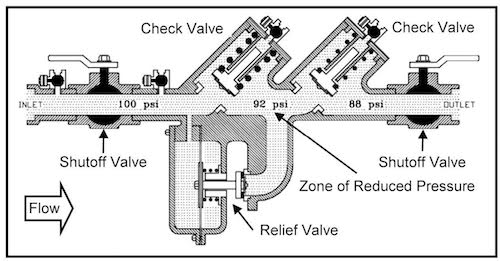What is a Backflow Preventer?
Is Your Drinking Water Threatened by Backflow? It’s possible! Most times, water flows in a forward direction from your water supply source or water system into your main line and then into your home. Backflow is a term that describes the flow of water when it takes a backward direction and flows back into your water supply. Essentially, backflow happens when the water in your home (as the name implies) flows back into the public water supply. Backflow can also be caused when water that is flowing through a garden hose makes its way or flows back into your home’s water supply. Backflow is caused by back pressure or sometimes back-siphoning of the plumbing system. If the water is pure, backflow is not an issue. But if the water that flows back contains bacteria or chemicals, then it can lead to a dangerous or unhealthy situation.
A garden hose is a common cause of backflow, typically when a pesticide or fertilizer applicator is attached to the hose. When using these applicators, any drop in water pressure can cause the supply system to “suck up” those chemicals into the water in the hose. Without an effective backflow preventer in place, these chemicals can be present the next time you (or even one of your neighbors) turns on the tap. Water pressure drops are common in all municipal supplies. Once a backflow preventer is installed, water is unable to flow back into the public supply lines. This device effectively creates a closed plumbing system.
The backflow preventer is a device that prevents your water system from becoming contaminated from water flowing backwards into your supply lines. A backflow preventer is installed where the water main is routed into your home. It is also a good idea to install a backflow preventer if you have a sprinkler system. For this application, the backflow preventer would be installed where the sprinkle lines feed into the ground. A backflow preventer might also be known as an air gap.
how do they work?


A backflow preventer is simplistic yet ingenious in its design. It is comparable to the design of the heart valve in the human heart in that it allows the flow of water through one way and then closes when there is pressure coming back through. The way it works is simple. When water is pulled through the “main” line in your water system, such as when you turn on the tap in the kitchen, start a load of laundry, or flush your commode, the water is siphoned through a branch line. During this process, the water brings with it whatever is in the line. In the case of a sprinkler system, for example, you may be using weed killer, fertilizer, and so on, to take care of your lawn. Without a backflow preventer on the sprinkler system cut-in, your water system can inadvertently draw those toxins into your water supply.
Preventing back flow
Preventing backflow is simple. Your first line of defense is to install a backflow preventer. You can also prevent backflow by avoiding submerging garden hoses in pools, tubs, sinks, spas, and so on that can contain harmful bacteria or dangerous chemicals.
Backflow means the undesirable reversal of flow of a liquid, gas, or suspended solid into the potable water supply; a backflow preventer is designed to keep this from happening. Points at which a potable water system connects with a non-potable water system are called cross connections. Such connections occur naturally in appliances such as clothes washers and dishwashers, but they must be carefully designed and installed to prevent backflow. Another common location for a backflow preventer is the connection of a fire sprinkler system to a water main, to prevent pressurized water from flowing from the fire suppression system into the public water supply.
Back-siphonage occurs when higher pressure fluids, gases, or suspended solids move to an area of lower pressure fluids. For example, when a drinking straw is used to consume a beverage, suction reduces the pressure of fluid inside the straw, causing liquid to move from the cup to inside the straw and then into the drinker’s mouth. This is an example of an indirect cross-connection, undesirable material being pulled into the system.
Back-pressure occurs for example when air is blown through the straw and bubbles begin to erupt at the submerged end. If instead of air, natural gas had been forced into a potable water tank, the gas in turn could be carried to a kitchen faucet. This is an example of a direct cross-connection, with undesirable material being pushed into the system.
Back pressure can force an undesirable contaminant to enter potable water piping. Sources of back pressure may be boilers, heat exchanging equipment, power washing equipment, fire sprinklers, or pumps in the water distribution system. In some cases there may be an almost continuous risk of overcoming the static water pressure in the piping. To reduce the risk of contamination, a backflow preventer can be fitted. A backflow preventer is also important when potentially toxic chemicals are used, for instance for commercial/industrial descaling of boilers, or when chemical bleaches are used for residential power washing.
A closely related device is the backwater valve, which is designed to prevent sewage from backing up into a building and causing basement flooding.
